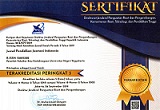Peran guru PJOK dalam mendukung program kesehatan sekolah dasar
Downloads
Tujuan penelitian ini adalah untuk mengukur seberapa besar kontribusi guru PJOK dalam mendukung program kesehatan sekolah dasar melalui Kegiatan Usaha Kesehatan Sekolah (UKS) di Sekolah Dasar di seluruh Kecamatan Sentolo Kabupaten Kulon progo. Penelitian ini menggunakan pendekatan deskriptif kuantitatif dengan metode survei dan pengumpulan data menggunakan kuesioner. Populasi penelitian mencakup 25 guru PJOK dengan teknik total sampling. Teknik analisis data penelitian menggunakan analisis deskriptif kuantitatif dalam bentuk persentase. Hasil penelitian menunjukkan bahwa perananan guru PJOK didalam Kegiatan Usaha Kesehatan Sekolah (UKS) di Sekolah Dasar di seluruh Kecamatan Sentolo Kabupaten Kulon progo presentase tertinggi yaitu masuk dalam kategori "cukup" sebesar 48% (12 guru). Kemudian kategori "tinggi" sebesar 24% (6 guru), kategori "sangat tinggi" sebesar 16% (4 guru), kategori "kurang" sebesar 12% (3 guru), dan kategori "Sangat Kurang" sebesar 0% (0 guru) atau tidak ada guru dengan kategori sangat kurang).
Abstract: The aim of this research is to measure how much PJOK teachers contribute to supporting elementary school health programs through School Health Business Activities in elementary schools throughout Sentolo District, Kulon Progo Regency. This research uses a quantitative descriptive approach with survey methods and data collection using questionnaires. The research population included 25 PJOK teachers using a total sampling technique. The research data analysis technique uses quantitative descriptive analysis in the form of percentages. The results of the research show that the role of PJOK teachers in School Health Business Activities in elementary schools throughout Sentolo District, Kulon progo Regency, has the highest percentage, namely in the "sufficient" category at 48% (12 teachers). Then the "high" category was 24% (6 teachers), the "very high" category was 16% (4 teachers), the "poor" category was 12% (3 teachers), and the "very poor" category was 0% (0 teachers), or there are no teachers in the very poor category.
Downloads
Apriani, L., & Gazali, N. (2018). Pelaksanaan trias usaha kesehatan sekolah (UKS) di sekolah dasar. Jurnal Keolahragaan, 6(1), 20–28. https://doi.org/10.21831/jk.v6i1.14456
Bakke, H. K., Bakke, H. K., & Schwebs, R. (2017). First-aid training in school: amount, content and hindrances. Acta Anaesthesiologica Scandinavica, 61(10), 1361–1370. https://doi.org/10.1111/aas.12958
Bañez-Coronel, M., Ayhan, F., Tarabochia, A. D., Zu, T., Perez, B. A., Tusi, S. K., Pletnikova, O., Borchelt, D. R., Ross, C. A., Margolis, R. L., Yachnis, A. T., Troncoso, J. C., Ranum, L. P. W., Roos, R. A. C., Perez, M., Jin, W., Le, D., Carlozzi, N., Dayalu, P., ... Frank, S. (2018). No 主観的å¥åº·æ„Ÿã‚’ä¸å¿ƒã¨ã—ãŸåœ¨å®…高齢者ã«ãŠã‘ã‚‹ å¥åº·é–¢é€£æŒ‡æ¨™ã«é–¢ã™ã‚‹å…±åˆ†æ•£æ§‹é€ 分æžTitle. Current Neurology and Neuroscience Reports, 1(1), iii–vii. https://doi.org/10.1016/j.jns.2018.09.022%0Ahttp://dx.doi.org/10.1016/j.ejphar.2009.04.058%0Ahttp://dx.doi.org/10.1016/j.brainres.2015.10.001%0Ahttp://www.pubmedcentral.nih.gov/articlerender.fcgi?artid=2854659&tool=pmcentrez&rendertype=abstract%0Ahttp://w
Behzadnia, B., Adachi, P. J. C., Deci, E. L., & Mohammadzadeh, H. (2018). Associations between students' perceptions of physical education teachers' interpersonal styles and students' wellness, knowledge, performance, and intentions to persist at physical activity: A self-determination theory approach. In Psychology of Sport and Exercise (Vol. 39). Elsevier Ltd. https://doi.org/10.1016/j.psychsport.2018.07.003
Borzucka-Sitkiewicz, K., & Kowalczewska-Grabowska, K. (2018). Health promoting schools in Poland: An evaluation of health promotion implementation at schools with a national certificate. New Educational Review, 53(3), 28–38. https://doi.org/10.15804/tner.2018.53.3.02
Brink, H. W., Loomans, M. G. L. C., Mobach, M. P., & Kort, H. S. M. (2021). Classrooms' indoor environmental conditions affecting the academic achievement of students and teachers in higher education: A systematic literature review. Indoor Air, 31(2), 405–425. https://doi.org/10.1111/ina.12745
Day, R. E., Sahota, P., & Christian, M. S. (2019). Effective implementation of primary school-based healthy lifestyle programmes: A qualitative study of views of school staff. BMC Public Health, 19(1), 1–16. https://doi.org/10.1186/s12889-019-7550-2
Griban, G. P., Lyakhova, N. A., Tymoshenko, O. V., Domina, Z. G., Dovgan, N. Y., Kruk, M. Z., Mychka, I. V., Tkachenko, P. P., Semeniv, B. S., Grokhova, G. P., Zelenenko, N. O., & Prontenko, K. V. (2020). Current state of students' health and its improvement in the process of physical education. Wiadomosci Lekarskie (Warsaw, Poland : 1960), 73(7), 1438–1447. https://doi.org/10.36740/wlek202007124
Herlitz, L., MacIntyre, H., Osborn, T., & Bonell, C. (2020). The sustainability of public health interventions in schools: A systematic review. Implementation Science, 15(1). https://doi.org/10.1186/s13012-019-0961-8
Karasievych, S., Maksymchuk, B., Kuzmenko, V., Slyusarenko, N., Romanyshyna, O., Syvokhop, E., Kolomiitseva, O., Romanishyna, L., Marionda, I., Vykhrushch, V., Oliinyk, M., Kovalchuk, A., Halaidiuk, M., & Maksymchuk, I. (2021). Training Future Physical Education Teachers for Physical and Sports Activities: Neuropedagogical Approach. BRAIN. Broad Research in Artificial Intelligence and Neuroscience, 12(4), 543–564. https://doi.org/10.18662/brain/12.4/264
Karlimah, K. (2016). The Ability Mathematics Connection Through Krulik & Rudnick Matematics Problem Solving Strategy and Problem Based Learning. Proceeding Icete 2016, October 2016. http://hamzanwadi.ac.id/
McHugh, C. A., Lloyd, J., Logan, S., & Wyatt, K. (2021). Implementing a set of health promoting processes in English secondary schools: A comparative case study. Public Health in Practice, 2(October), 100214. https://doi.org/10.1016/j.puhip.2021.100214
Whalsen Duli Agus Lauh. (2014). Dimensi Olahraga Pendidikan Dalam Pelaksanaan Penjasorkes Di Sekolah. Jurnal Pendidikan Olahraga, 3(1), 83–93.
Yuni, H., Nurhasanah, S., Nur, N. C., Markolinda, Y., & Augia, T. (2020). Optimalisasi Usaha Kesehatan Sekolah Melalui Perilaku Hidup Bersih Dan Sehat Di Sekolah Dasar 10 Timpeh. Buletin Ilmiah Nagari Membangun, 3(2), 97–106. https://doi.org/10.25077/bina.v3i2.200

Jurnal Pendidikan Jasmani Indonesia is licensed under a Creative Commons Attribution-ShareAlike 4.0 International License.
Based on a work at https://journal.uny.ac.id/index.php/jpji.











